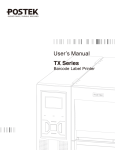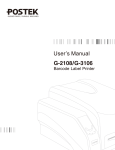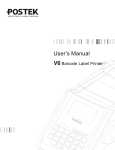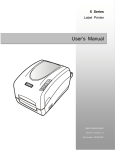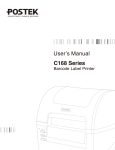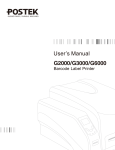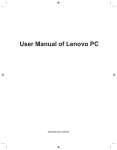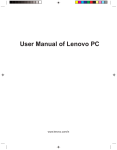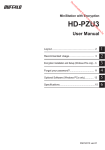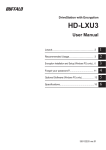Download Q8 Series User's Manual
Transcript
FCC Notice
This device complies with Part 15 of the FCC Rules. Operation is subject to the following two conditions: (1) this device
may not cause harmful interference, and (2) this device must accept any interference received, including interference that
may cause undesired operation.
This equipment may generate, use and/or radiate radio frequency energy. If not installed and used in full accordance with
this User’s Manual, interference to radio communications may occur. This equipment complies with the limits for a Class A
Information Technology Equipment pursuant to Part 15 of the FCC Rules, which are designed to provide reasonable
protection against such interference when operated in a commercial environment. Operation of this equipment in a
residential area may also cause interference. In such case the user, at his/her expense, will be required to correct the
interference using whatever means necessary.
Trademarks
POSTEK is a registered trademark by POSTEK Electronics Co., Ltd.
Microsoft, Windows are registered trademarks by Microsoft Corporation.
Copyright
© 2011-2015 by POSTEK Electronics Co., Ltd. All rights reserved. Under the copyright laws, this manual cannot be
reproduced in any form without the prior written permission of POSTEK. No patent liability is assumed with respect to the
use of the information contained herein.
POSTEK Q8 Barcode Label Printer User’s Manual
6th edition January 2015
Disclaimer
This manual has been validated and reviewed for accuracy. The instructions and descriptions it contains are accurate for the
Postek Q8 Label Printer at the time of this manual’s printing. However, succeeding printers and manuals are subject to
change without notice. Postek assumes no liability for damages incurred directly or indirectly from errors, omissions or
discrepancies between the printer and this manual.
Although this manual describes and details many issues, which could possibly occur, the manufacturer cannot warrant
against unpredictable conditions during the printing process. For problems such as the printer not working, lost or unclear
print content, etc., the manufacturer and resellers are responsible for correcting these issues (according to Postek Printer
Warranty Clauses). In no event shall the manufacturer or the resellers involved be liable for any damages whatsoever
including without limitation; damages for loss of business profits, business interruption, loss of business information, or
other pecuniary loss arising from the use of this product.
i
Important Safety Instructions
♦ Only qualified and trained authorized POSTEK service providers should attempt to disassemble or repair the printer.
Incorrect disassembling of the product or its power adaptor may cause an electronic short, human injury or printer
component damages.
♦ Do not use a worn or damaged power cord as it could result in electric shock and personal injury. If the power cord
becomes damaged or frayed, replace it immediately.
♦ Be sure that the output of the power adapter is 24VDC and your power source matches the rating listed on the power
adapter. Ensure the power source is grounded.
♦ Do not insert anything into the ventilation slots or openings on the printer.
♦ The printer and power adapter should never be operated in a location where either one can get wet. Personal injury may
result.
♦ The Printhead becomes hot while printing. To protect from damaging the Printhead and risk of personal injury, avoid
touching it.
♦ To obtain increased Printhead longevity and higher quality output, always use quality labels, tags and thermal transfer
ribbons. Check for quality supplies with a POSTEK reseller.
♦ Static electricity that accumulates on the surface of the human body or other surfaces can damage or destroy the
Printhead or electronic components in this device. DO NOT touch the Printhead or the electronic components with bare
hands.
♦ Place the printer on a flat, firm, solid surface.
Warnings:
This is a Class A product. In a domestic environment this product may cause radio interference in which case the user may
be required to take adequate measures (see FCC Notice).
Static electricity that accumulates on the surface of the human body or other objects can damage the print head or electronic
components in the V6 printer. Observe proper electrostatic safety precautions when handling.
♦ Power off the printer when not in use for extended periods of time.
♦ Never operate in a high temperature environment.
♦ Follow all recommendations and setup instructions included in this manual.
Preface / Important Notice
Q8 Series User’s Manual
Table of Contents
Table of Contents .............................................................................................................................................................. 1
Preface ............................................................................................................................................................................... 2
Important Notice, Read Me First! ....................................................................................................................................... 2
Chapter 1: Introduction ................................................................................................................................................... 3
Technical Specifications ..................................................................................................................................................... 3
Printer Specifications .................................................................................................................................................. 3
Power Adapter Specifications ..................................................................................................................................... 4
Contents of Box .................................................................................................................................................................. 4
Packing List ................................................................................................................................................................ 4
Chapter 2: Setup and Use ................................................................................................................................................ 6
Setting up the Printer........................................................................................................................................................... 6
Main Parts and Structures ........................................................................................................................................... 6
Connecting the Printer ................................................................................................................................................ 8
Interface Connection ................................................................................................................................................... 9
Installing the Ribbon ................................................................................................................................................. 10
Loading the Media .................................................................................................................................................... 14
Peel-off Mode ........................................................................................................................................................... 18
Cutting Mode ............................................................................................................................................................ 20
Adjusting the Position of Media Sensor.................................................................................................................... 21
Chapter 3: Operations and Settings .............................................................................................................................. 27
Basic Operations ............................................................................................................................................................... 27
Power Switch ............................................................................................................................................................ 27
The Front Panel ......................................................................................................................................................... 27
Advanced Operations ........................................................................................................................................................ 28
Media Sensor Calibration.......................................................................................................................................... 28
Self Test..................................................................................................................................................................... 28
Reset to Factory Default Settings .............................................................................................................................. 29
DIP Switch Panel ...................................................................................................................................................... 29
Windows Driver ........................................................................................................................................................ 30
Label Software .......................................................................................................................................................... 30
Chapter 4: Maintenance................................................................................................................................................. 31
Cleaning the Printhead ...................................................................................................................................................... 31
Cleaning the Platen Roller ................................................................................................................................................ 31
Cleaning the Printer Interior ............................................................................................................................................. 32
Chapter 5: Troubleshooting ........................................................................................................................................... 33
Error Indicators ................................................................................................................................................................. 33
Miscellaneous ................................................................................................................................................................... 34
Vertical Blank Lines Appear ..................................................................................................................................... 34
Printer Timeout Error Message ................................................................................................................................. 34
Data Sent but Not Printing ........................................................................................................................................ 34
Poor Printing Quality ................................................................................................................................................ 34
Recovery ................................................................................................................................................................... 35
Appendix A: IO Interface Specifications ...................................................................................................................... 36
RS232 Serial Interface ...................................................................................................................................................... 36
Appendix B: ASCII Table .............................................................................................................................................. 37
1
Preface
Q8 系列用户手册
Preface
Your POSTEK Q8 barcode label printer provides many outstanding features to enjoy. The POSTEK Q8 is compact, versatile,
and easy to use. It supports both direct thermal and thermal transfer printing methods, and employs an unparalleled print
engine that reduces noise and enhances durability.
This manual explains how to set up and begin using your POSTEK Q8 printer. It also provides detailed information on
configuring your Q8 printer, basic operations, maintenance and troubleshooting.
Please read this manual carefully and completely before using the POSTEK Q8 printer.
Important Notice, Read Me First!
A thermal Printhead can be easily damaged due to its precision construction. A Printhead damaged due to misuse is not
covered under the terms of the warranty. To ensure longevity of the Printhead, please note the following:
♦
♦
♦
♦
♦
♦
DO NOT scrape, or use tools that might damage the Printhead surface.
To protect from corroding the Printhead, DO NOT touch the Printhead with bare hands.
DO NOT use thermal paper or thermal transfer ribbon, which contains Na, K or Cl.
Keep Printhead away from any liquid or dampness.
Use a cotton swab dipped in anhydrous isopropyl alcohol to clean the Printhead only.
Always use high-quality consumables:
- When the Printhead module is closed, pressure is placed directly onto the Printhead; dirt such as paper scraps, sand,
dust and glue can scrape or damage the Printhead.
- The Printhead is also easily damaged by static electricity, which may be generated by poor quality ribbons. Always
inspect consumables for quality before purchasing.
Note: The Q8 Series printer functions under Direct Thermal or Thermal Transfer print methods. Thermal Transfer
is set as the factory default (requires ribbon for printing). However, if you need to print on Direct Thermal materials
(ribbon is not required), please contact your printer supplier or service provider to reduce the printhead pressure.
This can protect your printhead from early performance deterioration due to direct contact with the thermal
media. Any physical printhead damage caused by direct thermal printing is not covered under warranty.
Q8 Series User’s Manual
Chapter 1: Introduction
Chapter 1: Introduction
Technical Specifications
Printer Specifications
Mode
Q8/200
Printing method
Thermal transfer
Printing resolution
203 dpi (8 dots/mm)
Q8/300
300 dpi (11.8 dots/mm)
Max printing speed 4 ips (101.6 mm/s)
3 ips (76.2 mm/s)
Max printing width 4.09″(104 mm)
4.25″(108 mm)
Max printing length 157″ (3987.8 mm)
79” (2006.6 mm)
Memory
8 MB FLASH ROM, 16 MB SDRAM
Media
Roll-feed, die-cut, continuous, tags, tickets in plain paper or thermal paper
Width:4.33” (110 mm) max., 98“ (25 mm) min.
Supply roll: OD 5″ (127 mm) max., ID 1″ (25.4 mm) min.
Thickness: 0.003″~0.006″ (0.08~0.15 mm), including liner
Ribbon
Wax, Wax/Resin, Resin
Ribbon roll: OD 3″ (76.2 mm) max., ID 1″ (25.4 mm) core
Max width: 4.3” (110 mm); Max length: 360’ (100 M)
Fonts
Five built-in ASCII fonts; Optional multiple language fonts
Bar Code Types
1D Barcode : Code 39, Code 93, Code 128/subset A,B,C, Codabar, Interleave 2 of 5, UPC A/E
2 and 5 add-on, EAN-13/8/128, UCC-128, etc.
2D Barcode : MaxiCode, PDF417, Data matrix, etc.
Media sensor
Reflective
Interfaces
RS-232 Serial, USB2.0
Power rating
24 VDC Power adapter
Weight
5.29lbs (2.4 kgs)
Dimensions
Operation
environment
Storage
environment
Optional items
W 8.3” (211 mm) x D 10” (254 mm) x H 5.9” (150 mm)
Temperature: 32° F ~ +104° F (0° C ~ 40° C)
Relative humidity: 5% - 85% non condensing
Temperature: -40° F ~ +140° F (-40° C ~ 60° C)
Relative humidity: 5% - 85% non condensing
Guillotine Cutter, Media Guide Adaptor, External Rewinder
3
Chapter 1: Introduction
Q8 Series User’s Manual
Power Adapter Specifications
Input
Output
Environment
AC 100 ~ 240 V, 50 ~ 60 Hz
DC 24V, 2.5 A
32° F ~ 104° F (0° C ~ 40° C)
Contents of Box
Inspect the shipping carton(s) for possible shipping damage, if damage is discovered, notify the shipping company to
report the nature and extent of the damage.
Please check the items according to the Packing List. If there are any items missing, notify your authorized reseller.
Packing List
Q8 Printer
1 pc
Power Adapter
1 pc
USB interface cable
1 pc
Media Spindle
1 pc
Media Roll Guides
2 pcs
Quick Start Guide
1 pc
CD-ROM pack
1 pc
Ribbon Core
1 pc
Note: CD-ROM pack includes the Q8 printer driver, PosLabel software, Q8 User’s Guide and the Programming Manual.
Q8 Series User’s Manual
Chapter 1: Introduction
Printer
Power Adapter
USB Cable
Sample Media Empty core
Media Spindle
Media Roll Guide
Quick Start Guide
CD Rom
Figure 1: Printer and Accessories
5
Q8 Series User’s Manual
Chapter 2: Setup and Use
Chapter 2: Setup and Use
Setting up the Printer
Before setting up the printer consider the following:
1. Make sure there is adequate space around the printer for loading consumables and proper ventilation.
2. Make sure the printer is close to the host so the interface cable is easily accessible at either end.
Main Parts and Structures
9
1
2
3
4
5
6
8
7
Figure 2
1.READY Indicator
4.PAUSE Button
7.Media Exit
2.MEDIA Indicator
5.FEED Button
8.Cover Handle
3.RIBBON Indicator
6.CANCEL Button
9.Observation Window
Chapter 2: Setup and Use
Q8 Series User’s Manual
6
7
1
5
4
3
2
Figure 3
1.Ribbon Take-up
4.Printhead Module Plate
2.Printhead Bracket
5.Ribbon Release Knobs
3.Handle
6.Ribbon Supply
7.Media Compartment
7
Q8 Series User’s Manual
Chapter 2: Setup and Use
1
2
3
5
4
Figure 4
1.RS-232 Serial Interface
4.Power Jack
2.DIP Switches
5.Power Switch
3.USB Interface
Connecting the Printer
Warnings:
(1) Using the wrong power adapter will cause damage to your printer. POSTEK assumes no liability for any damage in
such cases. The rating for the printer is 24VDC.
(2) Do not operate the printer near heat sources, liquids or corrosive chemicals.
1.
2.
3.
4.
Make sure the printer is powered OFF.
Connect the power cord to the power adapter.
Connect the power adapter’s DC input plug to the power jack.
Plug the power cord into a live wall outlet.
Chapter 2: Setup and Use
Q8 Series User’s Manual
Interface Connection
The Q8 supports USB and RS-232 Serial interface connections.
Note: When connecting the Q8 to a computer via the USB cable, make sure to utilize the same USB port used during
the driver installation process, which enables the printer to retrieve needed commands or data from the PC. If the same
USB port is not available or not known, then in the printer’s Properties Dialogue Box, under the Ports tab, ensure the
current port location is checked.
To connect:
1. Make sure the printer is powered OFF.
2. The printer will identify the communication port automatically.
3. The default values of printer port can be obtained from the self-test report. (See Chapter 2: Operation Basics/
Advanced Functions/ Self Test)
4. Cable configurations for interfaces are found in Appendix A of this guide.
5. Please take the following measures to reduce cable noise.
- Restrict the length of the interface cable to less than 6’ (1.83 M) if possible.
- Keep the interface cable separate from power cords.
9
Q8 Series User’s Manual
Chapter 2: Setup and Use
Installing the Ribbon
Note: Load ribbon only when using the thermal transfer printing method. Remove any ribbon that may be loaded when
using the direct thermal printing method.
Warnings:
(1) The Q8 supports ribbons with ink on the outside only. Check the ribbon package for ink side specifications.
(2) Always install a ribbon with the ink side facing outwards. The ink side of the ribbon must face the media and NOT
the Printhead
(3) If using a ribbon less than 110 mm wide, place the ribbon roll in the middle of the Ribbon Spindle for proper
alignment.
(4) Make sure the inner diameter of the ribbon is 0.5″ (12.5 mm).
To install the ribbon:
1. Open the right cover of the printer and turn the handle to the “open” position. Flip down the Printhead Module
Plate (see Figure 5-1).
2. Remove the ribbon from its package, and place the roll into the Ribbon Supply area, pulling out the Ribbon
Release Knob to insert the roll, and allow the leading edge of the ribbon to fall underneath the Printhead module.
Ensure the ink side of the ribbon is facing down (see Figure 5-2).
3. Lead the ribbon below the Printhead module towards the front of the printer.
4. Attach the leading edge of the ribbon to an empty core. Mount the core onto the Ribbon Take-up using the Ribbon
Loading Knob.
5. Turn the Ribbon Take-up Knob clockwise to ensure ribbon is tight and smooth (see Figure 5-3).
6. Close the Printhead Module Plate and turn the handle to the “close” position to lock the Printhead Module (see
Figure 5-3).
Chapter 2: Setup and Use
Q8 Series User’s Manual
Figure 5-1
11
Q8 Series User’s Manual
Chapter 2: Setup and Use
Figure 5-2
Chapter 2: Setup and Use
Q8 Series User’s Manual
Figure 5-3
13
Q8 Series User’s Manual
Chapter 2: Setup and Use
Loading the Media
Q8 printers can be operated in three different modes: Standard mode, Peel-off mode, and Cutting mode.
- In Standard mode, each printed label remains on the backing liner.
- In Peel-off mode, each printed label is peeled away from the backing liner automatically.
- In Cutting mode, the printer automatically cuts the label after it is printed.
Note: Pell-off requires an optional Peeler Kit to be installed. Cutting mode requires an optional Guillotine Cutter to
be installed.
Standard Mode
To load media into the Q8 while using Standard Mode:
1. Lift the top cover to expose the Media Compartment.
2. Take out the Media Spindle (see Figure 6-1).
3. Load a Media Roll, with labels facing up, onto the Media Spindle, using the scale on the Media Spindle to position
the Media Roll in the middle of the Spindle.
4. Next, insert the two Media Roll Guides, with their smooth sides facing inwards towards the Media Roll, on each
side of the Roll on the Media Spindle. Push the two Media Roll Guides close to Media Roll (see Figure 6- 2).
5. Insert the entire unit into the printer’s Media Compartment.
6. Turn the Handle to the “open” position to open the Printhead module.
7. Route the labels under and pass the Media Guide Rod, and over and pass the Platen Roller to the front of the printer.
8. Slide the Media Guides to the edge of the media; don’t squeeze the labels, make sure they remain flat (see Figure
6-3).
9. Turn the Handle to the “close” position.
10. Close the cover and press the “FEED” button to feed the Media and ensure proper tracking. If the printer does not
correctly sense the top of each label, it may be necessary to perform the Media Calibration (see Operations).
Chapter 2: Setup and Use
Q8 Series User’s Manual
Figure 6-1
15
Q8 Series User’s Manual
Chapter 2: Setup and Use
Figure 6-2
Chapter 2: Setup and Use
Q8 Series User’s Manual
Media
Media Guide Rod
Platen Roller
Media Guide
Figure 6-3
17
Q8 Series User’s Manual
Chapter 2: Setup and Use
Peel-off Mode
To load media into the Q8 while using Peel-off Mode:
1. Set the 4th DIP Switch to the ON position.
2. Turn on the printer.
3. Reset the Peeler Module: Press and hold the “Cancel” button for 4 seconds, until the 3 indicator lamps begin to
blink simultaneously. Release the “Cancel” button and press it again one more time. Reset is complete.
4. Load a roll of ribbon. Push the Peeler Module to the “Open” state. Route the media as shown, pull the liner to make
sure it is tight, and then turn the Peeler Module to the “Close” state. Peeler Module installation is complete (see
Figure 6-4 and Figure 6-5).
ON
OFF
1
2
3
4
5
6
7
8
Label
Printhead Module
Liner
Figure 6-4
Chapter 2: Setup and Use
Q8 Series User’s Manual
Peeler under Open state
Label Path
Liner Path
Peeler under Close state
Figure 6-5
19
Q8 Series User’s Manual
Chapter 2: Setup and Use
Cutting Mode
1. Set the 3rd DIP Switch to ON to enable the cutter function (see Figure 6-6).
2. Turn on the printer.
3. Reset the Cutter: Press and hold the “Cancel” button for 4 seconds, the three lamps will blink simultaneously.
Release and press the “Cancel” button again, the Cutter is ready to use (see Figure 6-6).
4. Turn the Handle to the “open” position, and flip down the Printhead Module Plate. Lead the labels through the
Cutter, then close the Printhead Module Plate, and turn the Handle to the “close” position. Media roll is loaded (see
Figure 6-7).
Remarks: It is a must to reset the cutter before loading media, or else, the wrong location of cutter blade will cause
label fail to go through the cutter.
Figure 6-6
Chapter 2: Setup and Use
Q8 Series User’s Manual
Figure 6-7
Adjusting the Position of Media Sensor
1.
2.
3.
4.
Lift the top cover (see Figure 7-1).
Turn the Handle to the “open” position, take out the Media Sensor Cover to expose the Media Sensor (Figure 7-2).
Check the location of Media Sensor (see Figures 7-3, 7-4 and 7-5).
Remove the media sensor cover, remove the screw, adjust the media sensor to the appropriate position, then fix the
screw back(Figure 7- 7)
5. Put back the media sensor cover.
21
Q8 Series User’s Manual
Chapter 2: Setup and Use
Media Sensor Slot
Figure 7-1
Chapter 2: Setup and Use
Q8 Series User’s Manual
Media Sensor
Figure 7-2
2 – 5mm
Space
Figure 7-3
23
Q8 Series User’s Manual
Chapter 2: Setup and Use
Space
Figure 7-4
Space
Figure 7-5
Chapter 2: Setup and Use
Q8 Series User’s Manual
Media Sensor Cover
Figure 7-6
Figure 7-7
25
Chapter 3: Operations and Settings
Q8 Series User’s Manual
Chapter 3: Operations and Settings
Basic Operations
Power Switch
The power switch is on the back panel of the printer. The symbols on the switch are defined as follows:
━ —ON
〇 —OFF
The Front Panel
The Front Panel of the Q8 printer consists of:
- Three Indicator Lamps: MEDIA, READY and RIBBON
- Three multi function buttons: PAUSE, FEED and CANCEL
Indicator Lamps
The three lamps indicate the status of the printer (please refer to Chapter 4: Troubleshooting, for error indicators).
READY
MEDIA
RIBBON
- Solid: Indicates the printer is in the normal state;
- Blinking: Indicates the printer is in the ‘PAUSE’ state.
- Solid: Indicates the printer is in the normal state;
- Blinking simultaneously with READY: Running out of media;
- Solid: Indicates thermal transfer printing;
- Off: Direct thermal printing (no ribbon installed);
- Blinking simultaneously with READY: Running out of ribbon.
27
Q8 Series User’s Manual
Chapter 3: Operations and Settings
Buttons
The three buttons have different functions based on the mode of the operation is performed.
Advanced Functions
Mode
Basic Functions
Feed/Calibration
Feeds one label
Media Sensor Calibration
Pause/Self Test
- Press once to pause current print job
- Press a second time to resume printing
Self-test:
The Printer performs a self-test and prints
out a configuration report
Cancel/ Reset
- Cancel current batch of labels
- Forces the printer to continue working after
an error has been corrected
Reset:
Resets the printer to Factory Default
Settings
See Advanced Operations below
Advanced Operations
Media Sensor Calibration
It is necessary to perform a Media Sensor Calibration after each new roll of media is installed.
1. Press and hold the Feed/Calibration button for about 4 seconds.
2. The printer will feed several labels.
3. The three indicator lamps will stop blinking and remain lit; the printer is back to a normal state.
Self Test
1. Press and hold the Pause/Self Test button for about 4 seconds;
2. The printer will print out a configuration report and the three indicator lamps will stop blinking and remain lit. The
printer is back to a normal state.
3. The following information will be printed on the self-test report:
- Font list
- Hardware configuration and status
- Label parameters
- Firmware version
- Direct Thermal or Thermal Transfer printing method
Chapter 3: Operations and Settings
Q8 Series User’s Manual
Reset to Factory Default Settings
To reset the printer to factory default settings:
1. Press and hold the Cancel/ Reset button for 4 seconds, the three lamps will blink simultaneously (the printer will return
to normal state automatically if no operations are performed within 4 seconds);
2. Release and press the Cancel/ Reset button again;
3. The three indicators stop blinking and remain lit. The printer is now in its normal state.
Note: The printed label count and printed length may not be reset.
DIP Switch Panel
The DIP Switch panel is located on the back of the printer.
ON
O FF
1
2
3
4
5
6
7
8
Note: Turn off the printer before setting DIP switches.
29
Q8 Series User’s Manual
Chapter 3: Operations and Settings
DIP Bit
Functions
Remarks
1
ON: Direct thermal print
OFF: Thermal transfer print
Printing type setting
Default: OFF
2
ON: Tear off position
OFF: Edge of next label
Stop position setting
Default: OFF
3
ON: Cutter is installed
OFF: Cutter is not installed
Cutter setting
Default: OFF
4
ON: Peeler is installed
OFF: Peeler is not installed
Peeler settings
Default: OFF
5
Reserved and not available
6
ON: Enable IP setting
OFF: Disable IP setting
IP address setup
Default: OFF
8 7
0 | 0 – 9600,n,8,1
0 | 1 – 19200,n,8,1
1 | 0 – 38400,n,8,1
1 | 1 – 57600,n,8,1
RS232 Serial Port baud rate setting
0: OFF, 1: ON
Default: 00
7
8
* Please read the content in “Important Notice” section before setting your printer to direct thermal mode.
Windows Driver
The Q8 printer is compatible with the following operating systems:
•
•
•
•
Windows 7
Windows Vista
Windows XP
Windows 9X
•
•
•
Windows 8
Windows 2000
Windows 2003
Note: Prior to uploading a new driver or installing an updated driver, remove any old version of the driver that may be
stored in your computer.
Label Software
Each Q8 Series printer is packaged with powerful barcode label editing software.
Chapter 4: Maintenance
Q8 Series User’s Manual
Chapter 4: Maintenance
Warnings
(1) Make sure the printer is powered off before performing maintenance operations.
(2) The Printhead may be hot due to recent printing. Wait until the Printhead cools before performing maintenance.
(3) Use only anhydrous isopropyl alcohol to clean the print head.
Cleaning the Printhead
The Printhead is the mechanism that enables the ink to impact the label. Due to the Printheads precision construction and
necessary location in the printer, it comes into contact with consumables and therefore is susceptible to dirt accumulation. If
dirt is not removed, the Printhead may be damaged. To ensure longevity of the Printhead, follow the recommended
maintenance guidelines below:
Note: A Printhead damaged by misuse is not covered under warranty.
Clean the Printhead
Clean the Printhead after every (1) roll of ribbon use or every (3) rolls of label media use. To clean the Printhead:
1. Turn printer power off
2. Open the top cover of Q8 printer
3. Turn the handle to open.
4. Remove the ribbon (if applicable) and media
5. Use a cotton swab dipped in anhydrous isopropyl alcohol. Rub the swab along the Printhead until the swab no longer
accumulates ink
6. Let the Printhead dry before using the Q8 again
Cleaning the Platen Roller
The Platen Roller, located at the exit point and underneath labels, supports the labels as they feed out of the printer. The
roller can accumulate debris from consumables, such as dirt, sand, dust or glue. To ensure longevity of the Platen Roller,
follow the recommended maintenance guidelines below:
Clean the Platen Roller after every (3) rolls of label media used. To clean the Platen Roller:
1. Turn off the printer.
2. Open the top cover.
3. Remove the ribbon (if applicable) and media.
4. Use a cotton swab dipped in anhydrous isopropyl alcohol. Rub the swab along the Platen Roller while rotating the roller
until the swab no longer accumulates ink or debris.
31
Q8 Series User’s Manual
Chapter 4: Maintenance
Cleaning the Printer Interior
Over time, the printer’s interior may collect dust or debris from the consumables. It is advised to periodically clean the
printer’s interior in order to prevent the accumulated debris from damaging internal parts.
To clean the printer interior, use a cotton swabs dipped into anhydrous isopropyl alcohol and remove any debris.
Chapter 5: Troubleshooting
Q8 Series User’s Manual
Chapter 5: Troubleshooting
Error Indicators
Typically, when the printer is not functioning, the READY lamp on the front panel will begin blinking, the communication
between printer and the host would be interrupted, and the printer would stop working. Please check the LED indicators on
the front panel to detect the malfunction.
READY and MEDIA Lamps blink simultaneously:
Possible Cause
Recommended Solutions
Media sensor cannot detect labels
(1) Check and confirm the media has been loaded correctly
(2) Check the position of the media sensor and confirm it
could detect the media gap or black line
(3) Calibrate the media sensor
Media ran out
Load a roll of media
Media jammed
The Media Roll Guides are not firmly
positioned against the Media or have not
been installed.
Clear the jam
Media sensor is broken
Install the Media Roll Guides correctly as shown in Figure
6-2.
Contact an authorized POSTEK service provider for
technical support.
Note: If you are using continuous media without gaps or black lines, please make sure the correct Media Type settings are
input in PosLable software.
READY and RIBBON Lamps blink simultaneously:
Possible Cause
Ribbon ran out
Ribbon jammed
Ribbon Sensor error
Recommend Solutions
Load a new roll of ribbon
Clear the jam
Contact an authorized POSTEK service provider for
technical support.
Only READY Lamp blinks:
Possible Cause
Recommend Solutions
Serial I/O error
Check DIP switches for the baud rate settings
Memory overflow
a. Restart the printer
b. Reset the printer
33
Q8 Series User’s Manual
Chapter 5: Troubleshooting
Miscellaneous
Vertical Blank Lines Appear
If the printer prints vertical blank lines as shown in the below picture, it may be due to a dirty or defective Printhead. See the
table below for possible causes and solutions.
Cause
The Printhead is dirty.
Vertical lines still appear
after cleaning the
Printhead.
Corrective Action
Clean the Printhead. Follow the recommended maintenance guidelines
for cleaning the Printhead.
Contact an authorized POSTEK service provider for technical support.
Printer Timeout Error Message
Execute following corrective actions:
1. Check the interface cable for proper connection.
2. Ensure the Q8 printer is powered on.
If the trouble still exists, please contact an authorized POSTEK service provider for technical support.
Data Sent but Not Printing
1. Ensure the correct driver is chosen in the label software.
2. Reset the Q8 printer.
If the trouble still exists, please contact an authorized POSTEK service provider for technical support.
Poor Printing Quality
When experiencing poor print quality, check the following:
1.
2.
3.
4.
5.
Adjust print darkness setting value.
Adjust print speed setting value.
Clean the Printhead and the platen roller.
Poor quality printing may be caused from using a low quality ribbon. Change to higher quality ribbon.
Poor quality printing may be caused from using low quality media. Change to higher quality media.
Chapter 5: Troubleshooting
Q8 Series User’s Manual
Recovery
After the miscellaneous has been cleared, press the CANCEL button to clear the alarm or restart the printer to resume
the printing automatically.
Note: For errors not listed here, please contact an authorized POSTEK Service Provider for further assistance.
35
Q8 Series User's Manual
Appendix A: IO Interface Specifications
Appendix A: IO Interface Specifications
RS232 Serial Interface
The RS232 connector on the printer is a DB9F:
Pin
1
2
3
4
5
6
7
8
9
Direction
/
Out
In
In
Out
In
Out
/
Definition
/
TX
RX
CTS
Ground
RTS
DSR
DTR
/
Connection with the Host:
Host 25S
TX 2
RX 3
DSR 6
DTR 20
RTS 4
CTS 5
GND 7
………
………
………
………
………
………
………
Printer 9S
3 RX
2 TX
8 DTR
7 DSR
4 CTS
6 RTS
5 GND
Host 9S
RX 2
TX 3
DTR 4
DSR 6
RTS 7
CTS 8
GND 5
………
………
………
………
………
………
………
Printer 9S
2 TX
3 RX
7 DSR
8 DTR
4 CTS
6 RTS
5 GND
Alternately, you can connect the 3 wires.
Host 25S
TX 2
RX 3
GND 7
pin 4
pin 5
pin 6
pin 20
………
………
………
Printer 9S
3 RX
2 TX
5 GND
Host 9S
RX 2
TX 3
GND 5
pin 4
pin 6
pin 7
pin 8
………
………
………
Printer 9S
2 TX
3 RX
5 GND
Baud rate: 9600, 19200, 38400, 57600 (Baud Rate set by DIP switches 7–8)
Data format: always 8 data bits, 1 start bit and 1 stop bit.
Parity: always non parity.
Flow control: RTS/CTS (Hardware flow control).
If using software or drivers under the Windows environment, the flow control must be set to “hardware”
Any communications port can transmit data from the host (RS232 and USB). Preliminary communications settings are not
required since the printer will automatically detect which port is active. Never send data from 2 ports at the same time. Data
cannot be sent to more than one port simultaneously, otherwise, data corruption and print errors may occur.
Appendix B: ASCII Table
Q8 Series User’s Manual
Appendix B: ASCII Table
0
1
2
3
4
5
6
7
8
9
A
B
C
D
E
F
0
NUL
SOH
STX
1
2
XON
!
“
#
$
%
&
‘
(
)
*
+
,
.
/
XOFF
NAK
ACK
BEL
BS
LF
ESC
FF
CR
SO
SI
RS
US
3
0
1
2
3
4
5
6
7
8
9
:
;
<
=
>
?
4
@
A
B
C
D
E
F
G
H
I
J
K
L
M
N
O
5
P
Q
R
S
T
U
V
W
X
Y
Z
[
\
]
^
_
6
`
a
b
c
d
e
f
g
h
i
j
k
l
m
n
o
7
p
q
r
s
t
u
v
w
x
y
z
{
|
}
~
DEL
Remark: The € sign is included in the embedded table at DEC128 (HEX 80).
37









































